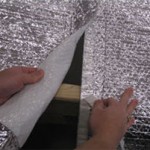Gross Misrepresentation?
Okay, so the title is a play on words – which you shall come to see shortly.
Hansen Pole Buildings’ Designer Dave Gross (get it) has been discussing a post frame building kit package with a client in Washington state. The client has also gotten a quote from a company from San Antonio, Texas – which was significantly less expensive, for several reasons (among them was not including freight to deliver the building from Texas to Washington).
The true topic for the day is in how the competitor was representing “Single Bubble Radiant/Condensation Barrier” as having an R-3 value.
For those enquiring minds who want to know what R values are all about: https://www.hansenpolebuildings.com/2015/06/entry-door-r-value/
To get to the bottom of the question, I went to the Reflective Insulation Manufacturers Association (www.rimainternational.org). This is what I found out:
RIMA International is dedicated to distributing reliable technical information to consumers and to expose exaggerated claims made by those who have misrepresented the performance of their reflective insulation, radiant barrier or interior radiation control coating product.
What is the R-value of radiant barrier?
 This question is often asked and is an indication that there is still some confusion between radiant barriers and reflective insulation. Radiant barriers are always installed with the reflective, (low emittance), surface facing an open air space. Because of a radiant barrier’s low emittance and high reflectance, it can block about 90 – 97% of the radiant heat that strikes the surface, significantly reducing the total heat transfer in and out of a building. However, due to variations in building construction, location and climate – one cannot assign a unique R-value to this application. Calculations can and have been made for very specific applications, but every given application requires its own evaluation.
This question is often asked and is an indication that there is still some confusion between radiant barriers and reflective insulation. Radiant barriers are always installed with the reflective, (low emittance), surface facing an open air space. Because of a radiant barrier’s low emittance and high reflectance, it can block about 90 – 97% of the radiant heat that strikes the surface, significantly reducing the total heat transfer in and out of a building. However, due to variations in building construction, location and climate – one cannot assign a unique R-value to this application. Calculations can and have been made for very specific applications, but every given application requires its own evaluation.
Reflective insulation, properly installed as part of a system, can be an effective method of condensation control and with the right dead air spaces, can afford a reasonable degree of R-value. However it is the SYSTEM, not the reflective insulation as a standalone, which is providing the R-value.






